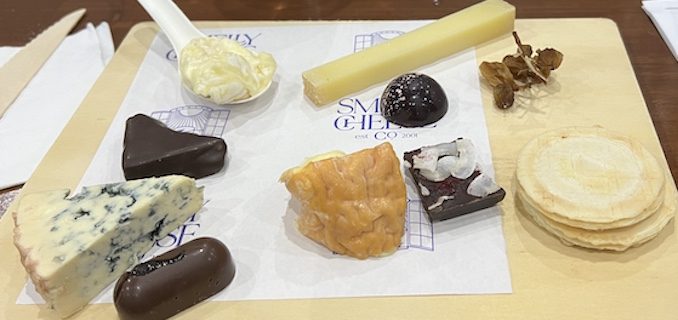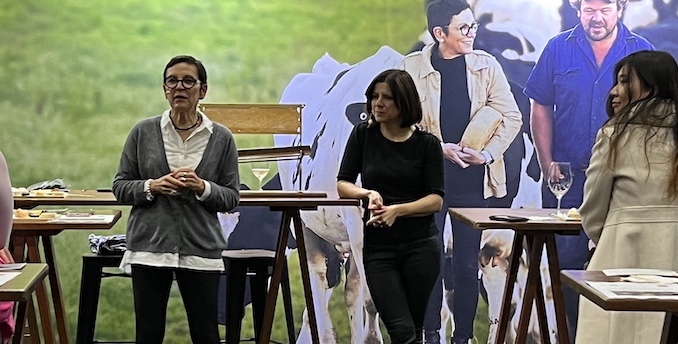
French Cheese is making a big push onto our shores. But the big problem is that Australians are still very behind when it comes to cheese appreciation. Bon Fromage is teaching Australians better ways to indulge in cheese with a string of workshops, events and festivals. We are lucky enough to attend a Cheese and Chocolate Masterclass at the Melbourne Food and Wine Show.
I sent a snap to my sister of the cheese and chocolate matrix I was about to experience. She was just waking up in Paris. “In all the Michelin star restaurants I’ve been to, I’ve never seen cheese and chocolate,” she says. Valerie Henbest, our Bon Fromage expert, and Ambassador, concurred. We are on the edge of a ballooning food trend. She tells us:
“Wine and cheese is so pre-Covid. Cheese and chocolate is the new thing,”
And who in their right mind would argue with that!
She explains that alcohol dulls the cheese experience and we need of all our senses as sharp as possible to really experience cheese appreciation. There is not a glass of alcohol in sight (not like the Riedel workshop next door).
Henbest tells us her cheese story. She moved to Australia because she fell in love. She started importing French cheese over 20 years ago when Australians were big on cheddar and had barely heard of Brie. She tells us the French eat 28 kilos of cheese a year, whereas Aussies only eat 12.5 kilos a year. What are we doing? She cajoles. Why are we wasting our time eating pre-processed foods when we could be eating delectable boutique French cheese. Very good question.
Here are her tips for eating French cheese:
- Touch your cheese.
Do not eat your cheese straight from the fridge. Give it time to soften and adjust to room temperature (around 20 – 24 degrees). Henbest recommends handling the cheese so temperatures get closer to body temperature (around 27 degrees). This maximises texture and provides “melt in the mouth” moments. Henbest also encourages us to rub the cheese on our hands to check oil content. She then asks us to lick our hands. While it seems perfectly normal to have twenty people licking cheese off the hands at the Melbourne Food and Wine Show, I’d think twice before doing it in a restaurant…… - Smell your cheese.
Pushing aromatic boundaries in the name of cheese is second nature to the French. And to Henbest, whose business is called the Smelly Cheese Shop. Bring it close to your nose, take in the bouquet whether it be refined muted nutty scents or malodorous pungent stink. Inhale deeply and acknowledge the smell. Give your brain time to process and associate the smell with what you are about to taste. It makes the appreciation linger and enhances the flavour.
We learn about the monks from Burgundy who created the Affidelice. It’s a creamy cheese washed in Chablis so the rind becomes orange and very smelly. It’s the only cheese forbidden to be carried on the Metro. We also learn that the origin of Roquefort’s penicillin is a loaf of mouldy bread left in a French cave many hundreds of years ago by a lovestruck farmer. And that it’s still there. - Inspect your cheese closely.
Is it yellow, white, orange, blue or black? Is there rind? Is it solid, spongey, or crumbly? Does the colour change as the temperature changes? Are there different colours throughout the cheese. As your knowledge of cheese deepens, the colours will take on different meanings. The colour of a cheese gives us a clue as to when the cheese was made. As the seasons change in France, the diet of the cow (and therefore chemical composition of the milk) changes. The more yellow the cheese, the more varieties of flowers the cow has eaten and the more likely the cheese was made in Spring/Summer. A whiter cheese means the cheese was more likely created in Winter and has greater fat and butter input.
We learn about the importance of cheese making traditions such as Fromage d’lePage, where cows walk to the high altitudes of the Alps when the snow melts to feast on an abundance of new flowers and grass and the milk is boiled on the spot to keep it fresh. This tradition dates back to the 1300s and is suddenly becoming increasingly popular for travellers with herds as small as 50 cows. - Listen to your cheese.
This might sound incredulous but we are told that crackers are a last resort. Good cheese should not be overpowered by the existence (i.e. crunch) of a cracker (not even gourmet expensive crackers). Crackers are a non, désolée. - Taste your cheese slowly with deliberation.
Make sure you pause to appreciate its full flavour. In this Cheese and Chocolate Masterclass we are forced to interrupt our cheese appreciation with chocolate appreciation (ah the misery). Each cheese is paired with a matching Australian made chocolate, expertly selected by Chocolatier, Vicki Papazharias from Adixions. Triple cream brie is paired with Tasmanian honeycomb wrapped in 64% dark chocolate and France’s second most popular cheese, the Comte, is paired with Dark Chocolate Café Noir. We dip the chocolate into the cheese and explore the combined flavours. The experts then tell us to marry the flavours in our mouths by adding more cheese and more chocolate. We are taken to the next level of both cheese and chocolate heaven. Simply divine.
Our masterclass concludes with a flourish of compliments to the teacher. We leave with a satiated palette and are enlightened on the virtues of combining our two favourite foods. We know it won’t be long before the trend pops up in Michelin starred restaurants.
For more French cheese education, samples and workshops don’t miss the Bon Fromage Festival starting next week. You’d be cheesy to miss it!
What: Bon Fromage Festival, Sydney FREE ENTRY
When: Thursday 1st – Saturday 3rd June 2023
Where: Overseas Passenger Terminal (Cargo Hall), 130 Argyle St, The Rocks More info: https://bonfromagefestival.au/
Instagram – @Europeancheeses
Facebook – @European Cheeses Australia

